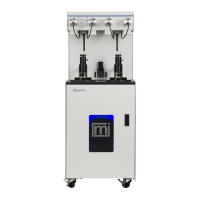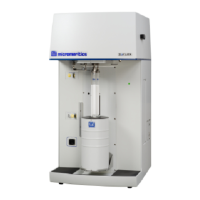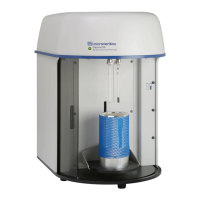Appendix F ASAP 2460 Operator’s Manual
F-8 246-42800-01 - Aug 2013
N2 - Cylindrical Pores - Oxide Surface
AR - Cylindrical Pores - Oxide Surface
Model isotherms were calculated using a combination of statistical mechanical calculations and exper-
imental observations for macroporous silicas and MCM-41 mesoporous silicas as well as zeolites. The
pore-filling pressures were determined as a function of the pore size from adsorption isotherms on
MCM-41 materials characterized by X-ray and other techniques. The variation of the pore fluid den-
sity with pressure and pore size has been accounted for by density functional theory calculations. The
N2 model reports pore sizes ranging from 3.8 to 387 Å and the AR model from 3.8 to over 500 Å.
N2 – Cylindrical Pores – Pillared Clay Surface (Montmorillionite)
Model isotherms were calculated using a combination of statistical thermodynamic Non-Local Density
Functional Theory (NLDFT) calculations and experimental isotherms for reference samples of mont-
morillionite. The construction method for the hybrid models was analogous to that described in the
first reference below (Jaroniec et al,1999). The additional references add additional theoretical details
as well as examples of the application of the model to pillared clay catalysts. This model reports pore
widths from 3.8 to 387 Å.
Geometry Cylinder
Substrate Oxide
Category: Porosity
Method: Nitrogen at 77 K; Argon at 87 K
Reference: M. Jaroniec, M. Kruk, J.P. Olivier, and S. Koch, “A New Method for the
Accurate Pore Size Analysis of MCM-41 and Other Silica-Based
Mesoporous Materials,” Proceedings of COPS-V, Heidelberg, Germany
(1999).
Geometry Cylinder
Substrate Crystalline Silicate
Category: Porosity
Method: Nitrogen at 77 K
